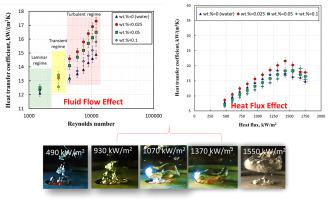当前位置:
X-MOL 学术
›
Powder Technol.
›
论文详情
Our official English website, www.x-mol.net, welcomes your
feedback! (Note: you will need to create a separate account there.)
Boiling flow of graphene nanoplatelets nano-suspension on a small copper disk
Powder Technology ( IF 4.5 ) Pub Date : 2021-01-01 , DOI: 10.1016/j.powtec.2020.08.083 Marjan Goodarzi , Iskander Tlili , Hazim Moria , E.M. Cardoso , Tawfeeq Abdullah Alkanhal , Ali E. Anqi , Mohammad Reza Safaei
Powder Technology ( IF 4.5 ) Pub Date : 2021-01-01 , DOI: 10.1016/j.powtec.2020.08.083 Marjan Goodarzi , Iskander Tlili , Hazim Moria , E.M. Cardoso , Tawfeeq Abdullah Alkanhal , Ali E. Anqi , Mohammad Reza Safaei

|
Abstract In the present work, an attempt was made to experimentally quantify the boiling heat transfer coefficient (BHTC) of graphene oxide-water nano-suspension (NS) inflow boiling heat transfer regime. The NS was prepared at weight fractions of 0.025, 0.05, and 0.1% using the two-step method and further stabilized for 17 days (at wt% = 0.1). Results showed that the presence of graphene oxide nanoplatelets (GNPs) imposed an extreme fouling thermal resistance (FTR) to the surface, which caused a reduction in the BHTC over 1000 min of continuous operation after the CHF point. This was mainly due to the presence of the graphene oxide on the surface, which created a surficial fouling layer and heat accumulation on the surface. Instead, the sedimentation layer promoted the critical heat flux (CHF) point such that the point for water was 1370 kW/m2 reaching 1640 kW/m2 for NS at wt% = 0.1. Likewise, the highest BHTC of 17.4 kW/(m2K) at Re = 10,950 was obtained. Also, with increasing the heat flux and flow rate, the BHTC increased. The same trend was also identified with a mass fraction of GNPs up to CHF point. The increase in the BHTC was attributed to the intensification of the Brownian motion and thermophoresis effect in the boiling micro-layer close to the surface.
中文翻译:

石墨烯纳米片纳米悬浮液在小铜盘上的沸腾流动
摘要 在目前的工作中,尝试通过实验量化氧化石墨烯-水纳米悬浮液 (NS) 流入沸腾传热机制的沸腾传热系数 (BHTC)。使用两步法以 0.025、0.05 和 0.1% 的重量分数制备 NS,并进一步稳定 17 天(wt% = 0.1)。结果表明,氧化石墨烯纳米片 (GNP) 的存在对表面施加了极大的污垢热阻 (FTR),这导致 BHTC 在 CHF 点后连续运行 1000 分钟后降低。这主要是由于表面上存在氧化石墨烯,这在表面形成了表面污垢层和热量积聚。反而,沉积层促进了临界热通量 (CHF) 点,使得水的点为 1370 kW/m2,在 wt% = 0.1 时达到 1640 kW/m2 的 NS。同样,在 Re = 10,950 时获得了 17.4 kW/(m2K) 的最高 BHTC。此外,随着热通量和流量的增加,BHTC 也增加。同样的趋势也被确定为高达 CHF 点的 GNP 的质量分数。BHTC的增加归因于靠近表面的沸腾微层中布朗运动和热泳效应的增强。
更新日期:2021-01-01
中文翻译:

石墨烯纳米片纳米悬浮液在小铜盘上的沸腾流动
摘要 在目前的工作中,尝试通过实验量化氧化石墨烯-水纳米悬浮液 (NS) 流入沸腾传热机制的沸腾传热系数 (BHTC)。使用两步法以 0.025、0.05 和 0.1% 的重量分数制备 NS,并进一步稳定 17 天(wt% = 0.1)。结果表明,氧化石墨烯纳米片 (GNP) 的存在对表面施加了极大的污垢热阻 (FTR),这导致 BHTC 在 CHF 点后连续运行 1000 分钟后降低。这主要是由于表面上存在氧化石墨烯,这在表面形成了表面污垢层和热量积聚。反而,沉积层促进了临界热通量 (CHF) 点,使得水的点为 1370 kW/m2,在 wt% = 0.1 时达到 1640 kW/m2 的 NS。同样,在 Re = 10,950 时获得了 17.4 kW/(m2K) 的最高 BHTC。此外,随着热通量和流量的增加,BHTC 也增加。同样的趋势也被确定为高达 CHF 点的 GNP 的质量分数。BHTC的增加归因于靠近表面的沸腾微层中布朗运动和热泳效应的增强。









































 京公网安备 11010802027423号
京公网安备 11010802027423号